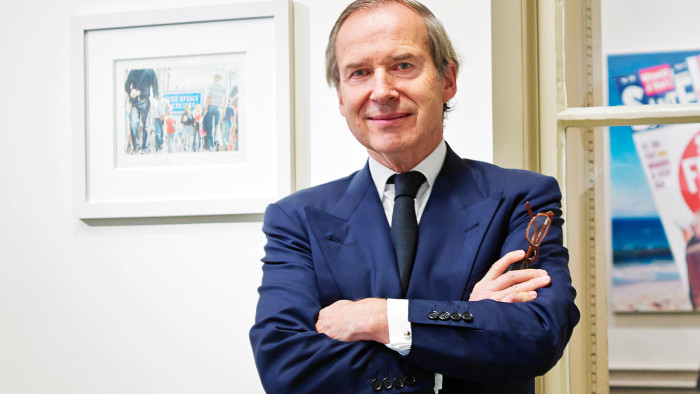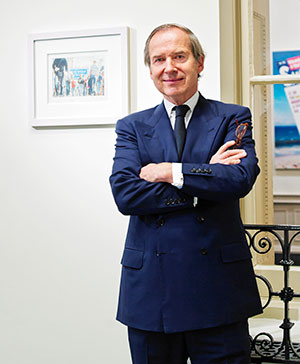Interview: auctioneer Simon de Pury

Simply sign up to the Life & Arts myFT Digest -- delivered directly to your inbox.
The number of ways of describing the auctioneer, curator, dealer, DJ, reality TV star and jet-setter Simon de Pury is almost endless: the Mick Jagger of art auctions, or “the man with the golden gavel”, according to a BBC documentary. A close acquaintance describes him as “Peter Pan” — venturesome, mercurial, ever-youthful — and notes his ability to reinvent himself constantly.
“Simon needs a happening; he’s addicted to the adrenalin. He’s got a tremendous career but he’s also obsessed with the newest thing,” dealer Adam Lindemann once said about him.
He almost single-handedly created a market for Swatch watches in the 1980s, and has sold multimillion-dollar works of art across the world — in four languages. He famously had no real home, living in hotels until his second marriage in 2010. Certainly, de Pury is legendary for his brilliance at auctioneering, for an awesome address book, and for his ability to beguile with charm, elegance and perfect old-world manners.
We meet on a rainy autumn day in the imposing offices of Kulczyk Investments in Mayfair, where the small team running de Pury’s latest venture — de Pury auctions — is camping while flood damage at his own home is repaired.
Jan Kulczyk, who died this summer, was Poland’s richest man and a collector; his daughter-in-law Kasia is also interested in art, and the offices have been used for exhibitions organised by de Pury’s parallel advisory and curating consultancy, de Pury de Pury.
The second “de Pury” of this art consultancy is Simon’s wife Michaela, a German art specialist who, like her husband, was previously with Phillips. They celebrated their wedding in 2010 in an over-the-top ceremony at the Saatchi Gallery in London. Guests arrived to discover that their table numbers corresponded to double beds, with the food spread out over the pillows and sheets, an installation by “food artist” Jennifer Rubell. The bride and groom were seen having their hair done through glass doors, which were shattered — with a hammer, of course — after they were finished, and they stepped out over the shards to join their guests. The evening ended late with de Pury DJing.
In his Mayfair base, as always perfectly turned out in his signature navy-blue double-breasted suit, hair brushed back with just a hint of a flick over his collar, de Pury poses good-naturedly for our photographer while Tate director Nicholas Serota wanders around looking at a show of works by the nonconformist Russian artist Erik Bulatov, the first to be held in London since 1989.

De Pury’s link with the Kulczyk family is in line with his many associations with wealthy patrons, starting in 1979 when he became a curator for the Thyssen-Bornemisza collection after studying art at Sotheby’s Institute and a spell with Swiss auction houses. But in 1986 he moved on, becoming chairman of Sotheby’s Switzerland; 10 years later he left Sotheby’s to start an art gallery with his colleague Daniella Luxembourg. “This was possibly one of the high points in his career, they had wonderful things,” says another dealer. “But Simon loves the limelight, this was rather low-profile for him.”
So soon enough they had merged the gallery with Phillips (creating Phillips de Pury) in 2001, when the luxury-goods mogul Bernard Arnault mounted an attempt to enter the top end of the art market. This turned into a disaster, and the ailing company was finally sold to the Russian luxury retailer Mercury. After a few years running it, de Pury left in 2012. “Mercury bought my shares,” he says, his face hardening for a moment; this is a sore point, as rumour had it he had been asked to leave. Indeed the only time I have ever seen him depart from his habitual imperturbability was when he strenuously denied this story: “I categorically wasn’t sacked!” he insisted.
What he does acknowledge is that his talents are not as an administrator; colleagues talk of reasonable chaos during his time at Phillips de Pury. “It’s true I am more interested in the big picture,” he says, “and I love working in a team with people who have management skills.” To this end he has recruited hedge-funder Arnaud Massenet as chief executive to look after the business side of de Pury auctions. Massenet’s former wife Natalie co-founded online retailer Net-a-Porter.
Until now, de Pury has often worked with other people’s money, and sometimes lost it, but he says that the new venture is funded by himself, his wife Michaela and Massenet, although he doesn’t say what percentage each holds.
“We are aiming at disrupting the market,” says Massenet, who seems genuinely enthused by this new project. “The big auction houses are opaque and charge massive commissions. We want to make the process more efficient and cheaper.” De Pury’s buyers’ fees are lower for less-expensive works: a flat 15 per cent up to $2m; afterwards 12 per cent, with no vendors’ commission. (By comparison, auction houses generally charge 25 per cent on cheaper lots, sliding down to 12 per cent as the price rises; vendors are charged commission of about 9 per cent on lower-value lots.)

The model of the new auction house is a hybrid, with the catalogue online, a physical presentation and a live auctioneer. But the venture is entering a crowded field in which Paddle8 in particular is making a big splash. Still, de Pury has some good ideas, notably a link-up with the art data site Artnet. Works for sale on de Pury will be linked via an “intelligence” button to ones on the data site, so giving buyers an idea of comparable values; there will be interviews with the artists and curators. “You will have all this instant information,” he says, “not just available to insiders but to everyone.” There will also be click-and-buy offerings of limited editions, he says. And not being constrained by a hard-and-fast sales schedule is certainly an advantage.
At the moment, however, all this has yet to be tested. The firm did hold one sale, in association with Christie’s, of a mixed bag of works from de Pury’s old friend the Belgian Baroness Lambert: it raised almost £15m. For the moment, no online sales or exhibitions are programmed but de Pury promises they will “soon be announced” and that he will hold two or three a year.
“Simon has so many qualities, but I’m not sure that this new direction is best for him,” says an old friend. “Ideally, he should have been at the head of a major auction house, schmoozing the clients internationally, using his charm and contacts but not involved in day-to-day running.”
What is incontestable is de Pury’s genuine love of art and interest in contemporary culture. A friend recounts how he once had a girlfriend who was also an artist: when he saw her art, which was apparently terrible, he instantly dropped her. I ask him if this is true and, laughing, he confirms it.
“I have a great curiosity and the result of my passions, I have known the art world from every imaginable aspect — from artist to curator, gallerist, collector and auctioneer,” he says. “And I am also obsessed with music, architecture, design, cinema, theatre . . . I don’t think you can ever get blasé, get tired of art.”
And with that, it is time for him to go. With an elegant wave of the hand and a last smile, he has disappeared down Grafton Street — off to Paris to conduct another benefit auction, and no doubt open to the possibility of yet another new adventure.
Photographs: Victoria Birkinshaw; Balkis Press/PA Archive
Comments